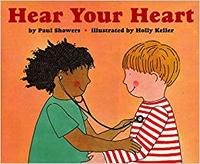Dinosaur Bones
分級讀本/橋梁書
Dinosaur Bones
P 580L
書籍資訊
| 適讀年齡 | 4 - 8 |
| 適合年級 | 1 - 3 |
| 字數 | 461 字 |
| Grade level equivalent | 3.0 |
| AR level | 3.7 |
| F&p/guided reading level | P |
| Lexile | 580L |
| DRA level | |
| 出版社 | HarperCollins |
| 出版日期 | March 1990 |
Discusses how scientists study fossil remains and provide information on how dinosaurs lived millions of years ago.
同系列的其他書籍

Why I Sneeze, Shiver, Hiccup, & Yawn
Ka-choo! Brrr. Yawnnnn.Have you ever wondered what makes you sneeze when you're in a dusty room? Or shiver when you get out of the bathtub? Or yawn when you're tired? All of these actions are reflexes. Your body makes them happen even though you don't tell it to.Budding young scientists will be amazed as Melvin Berger and Paul Meisel reveal the mysteries behind the reflexes that happen in our bodies every day and offer fun-filled experiments to try on family and friends. Let's Read and Find Out Science, Stage 2.
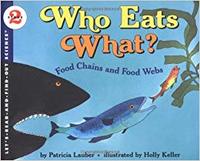
Who Eats What? Food Chains and Food Webs
Informative and intriguing, this science book teaches children to think about the complex and interdependent web of life on Earth. Every link in a food chain is important because each living thing depends on others for survival, no matter how big or how small. Lively drawings from Holly Keller illustrate the clear, simple text by Patricia Lauber. This is a Stage 2 Let's-Read-and-Find-Out, which means the book explores more challenging concepts for children in the primary grades. Let's-Read-And-Find-Out is the winner of the American Association for the Advancement of Science/Subaru Science Books & Films Prize for Outstanding Science Series. Supports the Common Core Learning Standards and Next Generation Science Standards

Did Dinosaurs Have Feathers?
Did Dinosaurs Have Feathers? Birds have feathers, but did you know some dinosaurs did too? New fossils have shown that as long as 145 million years ago, some dinosaurs had feathers, just as birds do. The birds you see outside your window are relatives of these ancient creatures. Ages 5-9

Where Did Dinosaurs Come From?
Stegosaurus had spikes along its back. Triceratops had long, sharp horns. Tyrannosaurus rex was enormous. Millions and millions of years before the first people lived, these fascinating creatures ruled the Earth. To find out where they came from, you have to look way back in time . . . 3.5 billion years ago! Come explore the biggest mystery of all: Where did dinosaurs come from? Read and find out!

Energy Makes Things Happen
This Stage 2 Let's-Read-And-Find-Out Science title clearly explains the different forms of energy and how it is transferred among people, machines, and the natural world.

You're Aboard Spaceship Earth
Explains how life is sustained on Earth through the presence of water, food, and oxygen, and how the planet is different from a spacecraft because it can rejuvenate its supply of these critical resources.

How Do Apples Grow?
Describes the life cycle of an apple from its initial appearance as a spring bud to that point in time when it becomes a fully ripe fruit.

Why Are the Ice Caps Melting?: The Dangers of Global Warming
The earth is getting hotter, and not just in the summer. The climate of your own hometown is changing. But why is this happening, and can we stop it? Read and find out!

What Will The Weather Be?
Explains the basic characteristics of weather--temperature, humidity, wind speed and direction, air pressure--and how meteorologists gather data for their forecasts.

The Sky Is Full of Stars
Young stargazers learn about different star colors and brightnesses, how to locate major constellations, and how to make mini planetariums by using coffee cans and flashlights. A fine job of encouraging young people to look at stars and constellations. . . . Highly recommended as a science resource book." Science and Children. "A dandy book for [primary grade] readers." AP.

What's So Bad About Gasoline?: Fossil Fuels and What They Do
Look around to see what uses oilcars, airplanes, boats, factories, and countless other machines. The world is dependent on oil as its main source of energy. Although oil is plentiful right now, the supply will eventually run out, and even worse, burning oil is very damaging to the environment. What alternatives can help us use less oil and how can we protect the environment? Read and find out!

The Sun: Our Nearest Star
Describes the sun and how it provides the light and energy which allow plant and animal life to exist on the earth.

What Happens To A Hamburger?
Explains the processes by which a hamburger and other foods are used to make energy, strong bones, and solid muscles as they pass through the digestive system.

Snakes Are Hunters
Let's-Read-and-Find-Out about SnakesSlithering, scaly, and slysnakes are fascinating reptiles. They are also hunters. Find out how snakes survive in the wild, and how they capture their prey.

Library Book: Earthquakes
This informative book explains how earthquakes happen, describes several major quakes, and discusses how to stay safe in an earthquake.

How Do Birds Find Their Way?
Birds don't need maps!Many birds make long journeys twice each year as they migrate between their winter and summer homes. Arctic terns fly more than 10,000 miles from the South Pole to northern Maine. Tiny little hummingbirds fly nonstop over the ocean for 500 miles. How do they know which way to fly? Why don't they get lost? Read and find out the many ideas scientists have come up with to explain this mystery.

Gravity Is A Mystery
This book defines gravity and discusses how our knowledge of the natural force has broadened and evolved.

Germs Make Me Sick!
How are you feeling?Most of the time you feel fine, but sometimes you get sick. Sometimes a germ catches up with you.Germs are all around you, but they are too small for you to see. Many germs are harmless, but two kinds, viruses and bacteria, can make you sick. Read and find out about germs, how they can make you sick, and how your body works to fight them off and keep you healthy.

Day Light, Night Light
Complete with full-color illustrations, a collection of fun facts, and interesting hands-on activities, this science book for young readers explores the realm of light, how it travels, the time it takes to travel from the sun to the earth, and more.

What Makes Day and Night
Accompanied by NASA photographs and Dorros's colorful, lively drawings, the text explains the Earth's rotation in clear and simple terms. An experiment using a lamp as the 'sun' further clarifies the principles introduced.' --BL.

How Mountains Are Made
29,028 feet tall and still growing?!Even though Mount Everest measures 29,028 feet high, it may be growing about two inches a year. A mountain might be thousands of feet high, but it can still grow taller or shorter each year. Mountains are created when the huge plates that make up the earth's outer shell very slowly pull and push against one another. Read and find out about all the different kinds of mountains.

Follow The Water From Brook To Ocean
Explains how water flows from brooks, to streams, to rivers, over waterfalls, through canyons and dams, to eventually reach the ocean.

Penguin Chick
An emperor penguin lays an egg on the Antarctic ice. In the bitter cold, miles away from the only source of food, how can the chick survive?
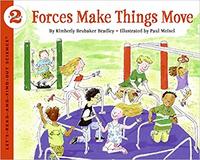
Forces Make Things Move
Simple language and humorous illustrations show how forces make things move, prevent them from starting to move, and stop them from moving.

The Moon Seems to Change
Can you see the moon?Does it look like a big round ball? Or is it just a sliver of light in the sky? The moon seems to change. But it doesn't really. The moon revolves around the Earth. It takes about four weeks to make the journey, and as it travels round we can only see certain parts of it. Try the simple experiment described inside using an orange, a pencil, and a flashlight, and you'll understand why the moon seems to change.

Let's Go Rock Collecting
Describes the formation and characteristics of igneous, metamorphic, and sedimentary rocks and how to recognize and collect them.

The Planets in Our Solar System
Where is it partly cloudy and 860蝪?Venus. Read about the eight planets in our solar system and Earth's special place in it. This book also includes instructions for making your own solar system mobile, and on the new "Find Out More" page learn how to track the moon and visit the best plant web sites.

Switch On, Switch Off
Explains the "magic" of how light switches work and the nature of electricity, discussing circuits and generators, light bulbs and plugs, and includes a simple experiment for children
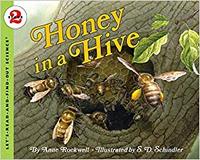
Honey in a Hive
In spring and summer, honeybees gather nectar to make into honey. These fascinating insects live and work together in complicated societies, complete with queen bees and workers. Read and find out about honeybees and their creation -- honey!

What Color Is Camouflage?
What do a fawn and a hermit crab have in common? They both use camouflage to hide from their enemies. A fawns spots help it blend in with its dappled surroundings, and a hermit crab might be mistaken for an empty shell. This lyrical introduction to camouflage explains how and why a wide variety of animals use it to go undercover. Readers can also hunt for camouflaged animals in every illustration.

Look Out For Turtles!
Describes the remarkable turtle, which can live almost anywhere, eat almost anything, range in size from tiny to gigantic, and live longer than any other animal.

Digging Up Dinosaurs
Briefly introduces various types of dinosaurs whose skeletons and reconstructions are seen in museums and explains how scientists uncover, preserve, and study fossilized dinosaur bones.

Oil Spill!
Explains why oil spills occur and how they are cleaned up and suggests strategies for preventing them in the future.

What Is the World Made Of? All About Solids, Liquids, and Gases
Let's-Read-and-Find-Out About Solids, Liquids, and GasesCan you make an ice cube disappear? Put it on a hot sidewalk. It melts into water and then vanishes! The ice cube changes from solid to liquid to gas. . . . Read on to find out more about the three states of matter.

Chirping Crickets
Describes the physical characteristics, behavior, and life cycle of crickets while giving particular emphasis to how they chirp.

Corn Is Maize
Describes the growth-cycle, cultivation, natural history, and worldwide diffusion and uses of corn in its evolved varieties

The Skeleton Inside You
What does your skeleton do?Your skeleton helps you leap, somersault, and touch your toeswithout it, you would be as floppy as a beanbag! There are over 200 bones living and growing inside you that make up your skeleton. There are also ligaments and joints that hold your bones together, and cartilage in your bendable parts like your ears and your nose. Learn all about what a skeleton can dobecause this isn't some make-believe Halloween skeleton, this is the real skeleton inside you.

Milk From Cow To Carton
Briefly describes how a cow produces milk, how the milk is processed in a dairy, and how various other dairy products are made from milk.

International Space Station
As tall as a 30-story building, orbiting Earth at 17,500 miles an hour, the International Space Station is a triumph of engineering. Includes a page of activities and a double-sided poster showing the complete station.

Spinning Spiders
Describes the characteristics of spiders and the methods they use to trap their prey in webs. A Let's-Read-And-Find-Out Science Level 2 title.
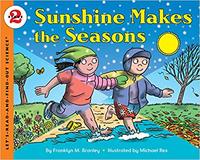
Sunshine Makes the Seasons
The sun shines down on us, giving warmth and light. But did you know that the sun also makes the seasons? As the earth makes one complete rotation around the sun every year, the seasons on the earth change -- from winter to spring to summer to fall and back to winter again. Find out how the light from the sun affects life on the earth for all living things in this look at the only star in our solar system.

Feel The Wind
Explains how the wind works--whether it is pushing the clouds along, blowing through hair, rustling the curtains, or roaring during a hurricane--and shows how to make a simple weather vane.

Dolphin Talk: Whistles, Clicks, And Clapping Jaws
Describes how dolphins communicate with each other in squeaks, whistles, and pops. A Level 2 Let's-Read-And-Find-Out Science book.

What Makes a Magnet?
Will a magnet pick up a paper clip or a feather? The answer is, just the paper clip. Magnets only pick up things that contain bits of iron. In this new addition to the Let's-Read-and-Find-Out Science series, veteran author Franklyn Branley explains the properties and behavior of magnets. True Kelley's charming illustrations will entertain readers as they discover for themselves what makes a magnet. Hands-on activities include making a magnet and compass.

An Octopus Is Amazing
"[Here is] a charming introduction to the truly amazing octopus [from its intelligence to its ability to change colors to the camouflaging black ink it squirts to escape predators]. Lauber's chatty, fact-filled text makes the book a good read-aloud, and Keller's amusing and colorful drawings enhance ita perfect match of text and illustration." SLJ. Children's Books of 1990 (Library of Congress)

Where Does the Garbage Go?: Revised Edition
Follow that garbage truck!...to the landfill to see how trash keeps piling up...to the incinerator to see how trash can be turned into energy ... to the recycling center to see how a soda bottle can be turned into a flowerpot. Filled with graphs, charts, and diagrams, Where Does the Garbage Go? explains how we deal with the problem of too much trash and provides ideas for easy ways to be a part of the solution.

Where Do Polar Bears Live?
Uniquely adapted for life on the ice, polar bears have skin and blubber that cover them like a warm blanket and fur between the pads of their paws to keep them from slipping. But many scientists believe that climate change, which is causing ice to melt in the Arctic, may make it impossible for polar bears to live in the wild by as soon as 2020.

Be A Friend To Trees
Discusses the importance of trees as sources of food, oxygen, and other essential things.

Tornado Alert
Describes the origin and nature of tornadoes and how to stay safe when threatened by one of these dangerous storms.

Fossils Tell of Long Ago
What is a fossil? Sometimes it's the imprint of an ancient leaf in a rock. Or it could be the skeleton of a dinosaur that has turned to stone! With clear prose and lovely, full-color illustrations, award-winning author and illustrator Aliki describes the different ways fossils are formed and what they tell us about life on Earth long ago. This book also includes an activity guide so kids can create their own fossils for someone to find a million years from now.This is a Stage 2 Let's-Read-and-Find-Out, which means the book explores more challenging concepts for children in the primary grades. Let's-Read-And-Find-Out is the winner of the American Association for the Advancement of Science/Subaru Science Books & Films Prize for Outstanding Science Series. Supports the Common Core Learning Standards and Next Generation Science Standards

Dinosaurs Are Different
Explains how the various orders and suborders of dinosaurs were similar and different in structure and appearance.

What The Moon Is Like
Provides beginning readers with an easy-to-read, colorfully-illustrated introduction to the moon and its many wonders.

How People Learned To Fly
Presents a short history and outline of the basic principles of flight, along with diagrams of some of the unusual contraptions that people used in their attempts to fly before the Wright brothers finally succeeded in 1903.

What Happened to the Dinosaurs?
What happened to the dinosaurs?For millions of years these fantastic creatures roamed our planet. Then, suddenly, they all disappeared. Scientists wonder why. What could have caused this huge extinction 65 million years ago?In this enlarged edition, distinguished writer Franklyn M. Branley and award-winning artist Marc Simont provide the perfect introduction to an always fascinating subject - the disappearance of the dinosaurs.Outstanding Science Trade Books for Children 1989 (NSTA/CBC)

Floating In Space
Examines life aboard a space shuttle, describing how astronauts deal with weightlessness, how they eat and exercise, and some of the work they do.

Mission to Mars
Let's-read-and-find-out about MarsSomeday people from Earth may live on Mars.In this century, we will go to the planet to learn more about it. It will become our outpost in space -- our space colony.
其他您可能會有興趣的書籍

Miss Small Is Off The Wall!
Teachers and students will enjoy this early chapter book series about A.J., a boy who hates school, and his weird experiences at school with his unpredictable teachers.

Ice Mummy ─ The Discovery of a 5,000-Year-Old Man
This Level 4 Step into Reading title describes the discovery of the frozen body of a man, who was found to be more than 5,000 years old.

Sam Samurai
Having lived through all the challenging adventures on their summer reading list, three young boys face their most fearsome adventure when they must conquer the Samurai warriors of the haiku.

The Princess of the Fillmore Street School
大偵探Nate the Great的表妹Olivia Sharp的偵探故事! Desiree想成為學校的公主,找Oliva幫忙達成她的這項計劃。在Oliva的幫助下,Desiree順利展開她的計劃。但卻因此又有兩個客戶找上Oliva:Duncan和校長! Desiree的公主計劃為什麼造成了其他人的新問題呢?Olivia如何不讓Desiree感覺受傷,又能成功解決其他人的困擾呢? 此系列雖不照順序閱讀並不影響劇情理解,但Desiree和Duncan是第一集中出現的角色,先讀過第一集,能更清楚Duncan和Olivia的對話內容。

Tonight On The Titanic (MTH #17)
Jack and Annie travel to the decks of that ill-fated ship, the "Titanic". There they help a toddler find her way to a lifeboat before they, themselves, are in grave danger of becoming two more victims of the tragic event.

Piper Green and the Fairy Tree: Too Much Good Luck
Book two of Ellen Potters charming new illustrated early chapter book series set on an island off the coast of Maine, where kids, lobster boats, and a hint of magic are part of everyday life. As far as Piper Green is concerned, the day started out lucky: Lucky thing #1: Her mom is painting Pipers bedroom her favorite color. Lucky thing #2: Piper found a perfect strawberry at breakfast. Lucky thing #3: Piper lost a tooth. And as everyone knows, tooth + tooth fairy = ka-ching! Theres just one problem. According to her friend Jacob, too much good luck can sometimes equal bad luck. And when Piper gets to school that day, Bad Luck is waiting for her. Will the Fairy Tree in Pipers front yard be enough to break her unlucky streak?

The Lightning Thief
Percy Jackson is a good kid, but he can't seem to focus on his schoolwork or control his temper. And lately, being away at boarding school is only getting worse-Percy could have sworn his pre-algebra teacher turned into a monster and tried to kill him. When Percy's mom finds out, she knows it's time that he knew the truth about where he came from, and that he go to the one place he'll be safe. She sends Percy to Camp Half Blood, a summer camp for demigods (on Long Island), where he learns that the father he never knew is Poseidon, God of the Sea. Soon a mystery unfolds and together with his friends -- one a satyr and the other the demigod daughter of Athena -- Percy sets out on a quest across the United States to reach the gates of the Underworld (located in a recording studio in Hollywood) and prevent a catastrophic war between the gods.

Bones
Describes how bones perform different functions as part of the human body.

Marvelous Mammals
A monkey is a mammal. A pig is one, too. To find out what other animals are mammals, read this marvelous book!

Who Was Martin Luther King, Jr.?
With clearly written text that explains this tumultuous time in history and 80 black-and-white illustrations, this Who Was biography celebrates the vision and the legacy of a remarkable man.

Dolphins At Daybreak (MTH #9)
Their magic tree house takes Jack and Annie deep into the sea, where they meet up with dolphins, sharks, and octopi as they search for the answer to an ancient riddle.

Mr. Tall
Mr. Tall has one long problem, his legs! Can anyone help him?

